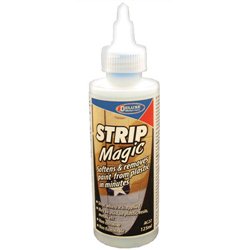Static grass puffer bottles work by manually charging model grass fibres with static electricity. When the charged...
No products
Product successfully added to your shopping cart
There are 0 items in your cart. There is 1 item in your cart.
Search Tips
How to safely strip enamel paint from a model?
Stripping enamel paint from a model can seem like a delicate process, but with the right tools and techniques, it's safe and effective. Whether you need to fix a mistake, start a repaint or restore an older model, careful preparation and patience are key.
Start by gathering your materials. You'll need a paint stripper that's safe for the type of plastic or material your model is made from. Household options like isopropyl alcohol, Dettol antiseptic liquid, or a specialised model paint remover such as Deluxe Materials' Strip Magic are good choices. Always check the product's compatibility with your model to avoid damage.
Before applying any paint remover, test it on an inconspicuous area of the model to ensure it doesn't soften or warp the material. Once you're confident it's safe, immerse the painted parts in the chosen solution. For Dettol, a full-strength soak for 6–12 hours works well. For isopropyl alcohol or specialised removers, follow the manufacturer's instructions. Make sure to wear gloves and work in a well-ventilated area to protect yourself from fumes or skin irritation.
After soaking, use a soft-bristled toothbrush or cotton buds to gently scrub the paint off. Be patient, as enamel paint can be stubborn, especially if it's been on the model for a long time. Avoid using hard brushes or excessive force, as these can scratch or damage delicate details. If necessary, repeat the soaking and scrubbing process for stubborn areas.
Once the paint is removed, thoroughly rinse the model in warm, soapy water to remove any residue from the paint stripper. Let the model dry completely before inspecting it for any leftover paint or damage. If you plan to repaint, lightly sand the surface with fine-grit sandpaper or a sanding stick to smooth any imperfections and ensure good adhesion for the new paint.
Finally, dispose of the used paint stripper responsibly. Many products can't be poured down the drain and require special disposal methods. Check local council guidelines for proper handling of hazardous materials. With care and attention, you'll have a clean model ready for its next transformation.
Click here to receive the tips weekly in your mailbox. You can unsubscribe at any time.








